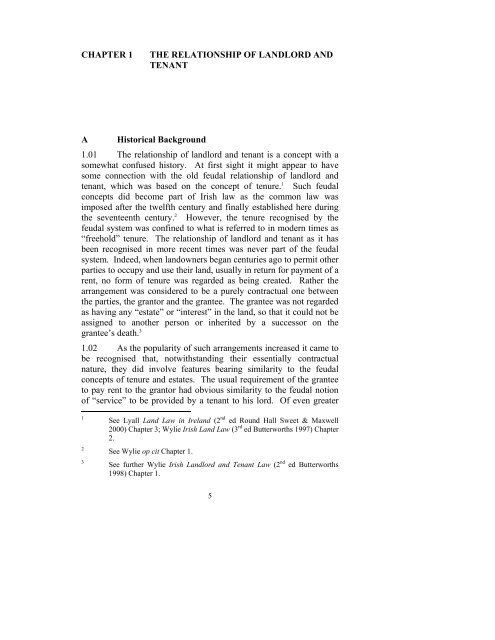Consultation Paper on the General Law of the Landlord and Tenant
Consultation Paper on the General Law of the Landlord and Tenant
Consultation Paper on the General Law of the Landlord and Tenant
You also want an ePaper? Increase the reach of your titles
YUMPU automatically turns print PDFs into web optimized ePapers that Google loves.
CHAPTER 1THE RELATIONSHIP OF LANDLORD ANDTENANTA Historical Background1.01 The relati<strong>on</strong>ship <strong>of</strong> l<strong>and</strong>lord <strong>and</strong> tenant is a c<strong>on</strong>cept with asomewhat c<strong>on</strong>fused history. At first sight it might appear to havesome c<strong>on</strong>necti<strong>on</strong> with <strong>the</strong> old feudal relati<strong>on</strong>ship <strong>of</strong> l<strong>and</strong>lord <strong>and</strong>tenant, which was based <strong>on</strong> <strong>the</strong> c<strong>on</strong>cept <strong>of</strong> tenure. 1 Such feudalc<strong>on</strong>cepts did become part <strong>of</strong> Irish law as <strong>the</strong> comm<strong>on</strong> law wasimposed after <strong>the</strong> twelfth century <strong>and</strong> finally established here during<strong>the</strong> seventeenth century. 2 However, <strong>the</strong> tenure recognised by <strong>the</strong>feudal system was c<strong>on</strong>fined to what is referred to in modern times as“freehold” tenure. The relati<strong>on</strong>ship <strong>of</strong> l<strong>and</strong>lord <strong>and</strong> tenant as it hasbeen recognised in more recent times was never part <strong>of</strong> <strong>the</strong> feudalsystem. Indeed, when l<strong>and</strong>owners began centuries ago to permit o<strong>the</strong>rparties to occupy <strong>and</strong> use <strong>the</strong>ir l<strong>and</strong>, usually in return for payment <strong>of</strong> arent, no form <strong>of</strong> tenure was regarded as being created. Ra<strong>the</strong>r <strong>the</strong>arrangement was c<strong>on</strong>sidered to be a purely c<strong>on</strong>tractual <strong>on</strong>e between<strong>the</strong> parties, <strong>the</strong> grantor <strong>and</strong> <strong>the</strong> grantee. The grantee was not regardedas having any “estate” or “interest” in <strong>the</strong> l<strong>and</strong>, so that it could not beassigned to ano<strong>the</strong>r pers<strong>on</strong> or inherited by a successor <strong>on</strong> <strong>the</strong>grantee’s death. 31.02 As <strong>the</strong> popularity <strong>of</strong> such arrangements increased it came tobe recognised that, notwithst<strong>and</strong>ing <strong>the</strong>ir essentially c<strong>on</strong>tractualnature, <strong>the</strong>y did involve features bearing similarity to <strong>the</strong> feudalc<strong>on</strong>cepts <strong>of</strong> tenure <strong>and</strong> estates. The usual requirement <strong>of</strong> <strong>the</strong> granteeto pay rent to <strong>the</strong> grantor had obvious similarity to <strong>the</strong> feudal noti<strong>on</strong><strong>of</strong> “service” to be provided by a tenant to his lord. Of even greater123See Lyall L<strong>and</strong> <strong>Law</strong> in Irel<strong>and</strong> (2 nd ed Round Hall Sweet & Maxwell2000) Chapter 3; Wylie Irish L<strong>and</strong> <strong>Law</strong> (3 rd ed Butterworths 1997) Chapter2.See Wylie op cit Chapter 1.See fur<strong>the</strong>r Wylie Irish <strong>L<strong>and</strong>lord</strong> <strong>and</strong> <strong>Tenant</strong> <strong>Law</strong> (2 nd ed Butterworths1998) Chapter 1.5
















